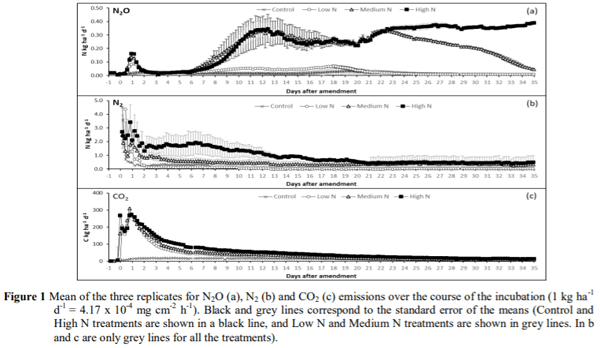N2O and N2 fluxes from cow urine patches with different loading rates of N in an Andisol in southern Chile
Published: April 21, 2021
By: Magdalena Ramírez S. 1,2; Dante Pinochet T. 1; María López-Aizpun 3; Nadine Loick 3; Jordana Rivero V. 3; Laura Cárdenas 3. / 1 Instituto de Ingeniería Agraria y Suelos, Facultad de Ciencias Agrarias, Universidad Austral de Chile, Valdivia, Chile; 2 Escuela de Graduados, Facultad de Ciencias Agrarias, Universidad Austral de Chile; 3 Rothamsted Research, North Wyke, Okehampton, Devon, EX20 2SB, UK.
INTRODUCTION
Grazed pasture soils are a potential source of nitrous oxide (N2O) due to elevated inorganic N pools. N2O is the dominant source of microbial denitrification, and under suitable conditions, N2O may be reduced in the soil to the environmentally harmless di-nitrogen gas (N2). One of the key nitrogen (N) sources is urine deposited from grazing animals. The loading rate of N in a cow urine patch is determined by the dietary N intake by the animal and the subsequent concentration of N in the urine. Although there are some studies in Chile that assess the N2O emission after fertilizer application (Alfaro et al., 2018), the impact of cattle urine patch on N2 and N2O emissions in an Andisol of southern Chile is unknown. The objective of this work was to evaluate the N2O and N2 emissions from cow urine patches with different loading rates of N in an Andisol.
MATERIALS AND METHODS
Soil was collected in March 2019 from a natural multispecies grassland located in the south of Chile (Valdivia series, Andisol, Typic Hapludands; 39°47'10 S 73°13' W). Urine was manually collected from at least seven Jerseys cows during milking in the morning, from a dairy farm located near to Sampford Courtenay, Okehampton, UK. Cow urine contained 2.89 ± 0.04 g L-1 total N and 12.4 ± 0.04 g L-1 total organic C. The soil incubation was carried out using the DENItrification System (DENIS), a specialized gas-flow-soil-core incubation system (Cardenas et al., 2003), at Rothamsted Research North Wyke, UK. Thirteen cores were packed with soil sieved to 2 mm to a bulk density of 0.7 g cm3 (simulating the in situ soil bulk density) into stainless steel rings in a height of 7.5 cm and an internal diameter of 14 cm. One core was used for the soil analysis before starting the incubation. Thus, the experiment was made with four treatments with three replicates in a randomized design. The treatments were urine solutions with different N concentration giving different loading rates of N: 0 kg N ha-1 (Control), 238 kg N ha-1 (Low N), 453 kg N ha-1 (Medium N) and 900 kg N ha-1 (High N). To reach the different concentrations of N in the urine for each treatment, urea powder was added. The soil moisture was adjusted to 85% of water filled pore space (WFPS) to ensure denitrification conditions. Fluxes of N2O, N2 and CO2 were quantified. Cumulative emissions of N2O, N2 and CO2 were calculated from the area under the curve after linear interpolation between sampling points and considering all the incubation time. Differences in total emissions for each gas measured between treatments were calculated by ANOVA using GraphPad Prism 8.
RESULTS AND DISCUSSION
Nitrous oxide (N2O) fluxes (Fig. 1 a) started to increase instantly after amendment application and showed a short peak of emissions in the day 2 after starting the incubation, decreasing again until day 6. Treatments Medium N and High N showed a second increase with peaks higher than the first peak, lasting 10 days for the Medium N treatment. However, the High N treatment continued with a plateau of emissions until the end of incubation. Behavior of di-nitrogen gas (N2) fluxes (Fig. 1 b) were very similar in all treatments, showing high emissions directly after amendment application and decreasing the next days until stop the experiment. Carbon dioxide (CO2) emissions increased instantly after amendment application (Fig. 1 c), reaching the first day of incubation the maximum average fluxes, decreasing gradually along the experiment. The maximum cumulative emission of N2O was in the High N treatment. Cumulative emissions over the course of the experiment showed that losses of N via N2O emissions were significantly higher in Medium N and High N than treatments with lower N content, representing 1.51 and 0.95% of the total N available in the soil, respectively. The maximum rate of losses coming as N2 were 3.68 and 3.50% representing 2.42 and 3.69 times more emissions than N2O, for Medium N and High N treatment, respectively.

CONCLUSIONS
In an Andisol, denitrification losses (N2O + N2) can reach 5% of the total N applied to the soil. N2 represents around 80% of the total denitrification, while N2O is near to 20%.
Abstract presented at the XLV Annual Congress Sochipa, Chile, 2020.
References
ALFARO, M., SALAZAR, F., HUBE, S., RAMIREZ, L., MORA, M.S., 2018. Ammonia and nitrous oxide emissions as affected by nitrification and urease inhibitors. J Soil Sci Plant Nut 18, 479-486.
CARDENAS L.M., HAWKINS J.M.B., CHADWICK, D., SCHOLEFIELD, D. 2003. Biogenic gas emissions from soils measured using a new automated laboratory incubation system. Soil Biology & Biochemistry 35, 867–870.
Content from the event:
Related topics:
Recommend
Comment
Share
Kansas State University
22 de abril de 2021
Please can you give me some information about measurement of N2O and CO2 ? What kind of analyser have you used?
Recommend
Reply

Would you like to discuss another topic? Create a new post to engage with experts in the community.





.jpg&w=3840&q=75)